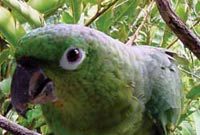Up Close with Parrots: Q&A With Eduardo Iñigo-Elias
January 15, 2009

Eduardo E. Iñigo-Elias, coordinator of the Neotropical Conservation Initiative at the Cornell Lab of Ornithology, has spent many years researching parrots. Eduardo is an expert on Mexico’s endangered birds, focusing attention on wild birds captured for the caged-bird trade, the overriding conservation issue for parrots and finches. He received his Ph.D. from the University of Florida, Gainesville, for his work on the landscape ecology and conservation biology of the Scarlet Macaw in the Gran Peten region of Mexico and Guatemala.
What attracts you to parrots?
One of the things that attracts me is their diversity—in size, from the tiny parrotlet that’s just a few inches long to the large macaws; and in colors, like Scarlet Macaws in reds and blues—all these vivid colors in the middle of the jungle where everything is green. Parrots remind me of nature gone wild. When the world was created, I think parrots came in the spring—full of brilliant colors.
The other reason I like parrots is that where I grew up in Mexico it was common to see them in the streets and pet stores. I always thought it was terrible to have them in captivity—that I would love to see them more in the wild. And little by little, I started learning that the main problem for conservation of parrots in the world is the taking of parrots from the wild to supply the domestic and international pet trade. Internationally, between 80 to 90 percent of the parrots of the world are declining. And those 80 or 90 percent are already listed for protection from trade, but there’s still poaching—illegal trade—and the populations are still declining. There are few examples of success in restoring parrots, and cases where the parrots are gone forever. The Cuban Macaw is extinct because of all the trade in the 1800s. And the famous Carolina Parakeet—the only native parakeet that once lived in the U.S.—is also extinct.


How smart are parrots?
I think all birds have some level of intelligence. But definitely birds in the crow family and parrots are very intelligent creatures.
Most of my experiences with parrots have been in the field, with wild birds. I had a chance to meet Alex the African Grey Parrot once and it was amazing to see all the things that he was capable of doing and teaching to the other parrots. According to the researchers who were working with Alex, he was close to a five-year-old human in the things he was able to do.
Which parrot is your favorite?
I think large macaws are interesting because of their size and their movement. They can travel in one day almost 40 miles just to eat and return to their roosting site. They are also interesting because they stay together in pairs. And that beautiful color! For example, the Hyacinth Macaw is a deep blue color with black in contrast with yellow around the eyes.
How much are wild parrots studied?
Parrot behavior in the wild is hard to study because parrots live in remote areas, in very inaccessible jungles, and they’re hard to see through all the vegetation. Very few people have conducted long-term research, though there have been more studies in the last 10 years. The boom of research and information now is amazing, but there have very few studies of parrots lasting longer than 10 years. The most important project that I know of is from the University of California in Berkley by Steve Beissinger studying Forpus—little parrotlets in Venezuela. There are also a few studies in Australia on cockatoos, and that’s it for long-term studies. Most projects are for a single dissertation or thesis, based on very few years of work. But what we know from these studies is that parrots spend lots of days with their chicks after they’ve hatched. They may spend months after they’ve fledged feeding them, foraging for them, and taking care of them. It can be up to another year before large macaws breed again, or even longer.
What would you like everyone to know about parrots?
I wish people would experience parrots in the wild, rather than in zoos or other captive situations. The first time I saw macaws in Mexico in the early 1970s, flocks numbered 60–80 birds! It was thrilling to see, every night, these large flocks of macaws flying to their roosting site. It was unbelievable! Now you don’t see that—10 birds flying together is a lot. That’s scary.
If people were more involved in ecotourism, then local people could see the value of the birds and understand that it’s better to keep them there in the wild than to sell them for the pet trade. Cutting down a nest tree, they’re going to get a hundred dollars, but just once. If they keep the birds in the wild and protect them, they will have a resource that tourists visit constantly. That is already happening in some places, but we need much more.
Originally published in the January 2009 issue of BirdScope.


All About Birds is a free resource
Available for everyone,
funded by donors like you






